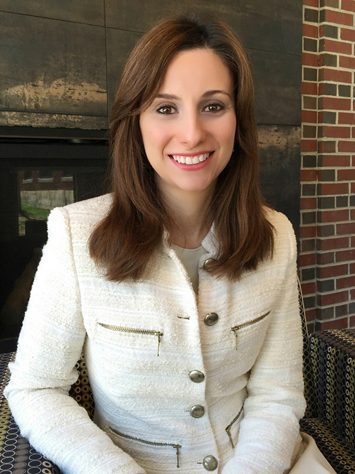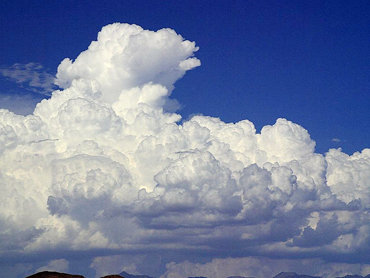Spring 2015
Earth Systems Science
WHEN MUGE KOMURCU looks skyward at passing clouds, she admires their beauty and mercurial nature like any good cloud watcher. But she notes, "When I see a cloud, I think about the small ice particles and cloud droplets inside."
The focus of Komurcu's scientific research is understanding how clouds work or, more specifically, modeling how they influence climate by either absorbing or reflecting sunlight—in large part a function of whether they are made up mostly of water or ice.
 |
|
| Muge Komurcu. Photo by Zikri Bayraktar. |
A native of Istanbul, Turkey, Komurcu came to the Earth Systems Research Center in early 2014 as a member of climate modeler Matt Huber's Climate Dynamics Prediction Lab and brought needed expertise in the biggest mystery of climate modeling—the role of clouds.
As Huber says, “Clouds are the heavy lifters in the climate system and they’re also the most uncertain aspect of climate models.”
Prior to UNH, Komurcu was a postdoc researcher at Yale University where she worked on clouds in global-scale models. At Yale, she led a multi-institutional team of researchers in a study comparing how clouds are currently represented in half a dozen general circulation models. The study was the first to show the difference in simulated cloud phases and how those differences affect clouds' radiative forcing properties, or their tendencies to reflect or absorb heat. As lead author, Komurcu published the study’s results in the Journal of Geophysical Research-Atmospheres.
"I ended up at Yale working on global-scale models because I like clouds and I realized they are not well represented in the models," Komurcu says. "And I knew that representation was worse in global-scale models because the resolution is very coarse and cloud-scale processes are extremely small. What's more, we don't really know some of the processes related to ice inside clouds."
The microphysics of ice crystals is complex and poorly understood, which means they are not well represented, or "parameterized," in models. The ever-shifting shapes of ice crystals, and how and where clouds are formed are all things that determine a cloud's radiative properties.
"You need to do very expensive lab studies and field experiments to understand all this," Komurcu says. "And the ice crystal formation process can change depending on a number of variables."
For example, over time inside a cloud, ice particles will grow larger and eventually fall out. But how they grow depends on the local temperature and vapor pressure, cloud circulations, and how the particles morph into different shapes that can affect whether or not they fall slowly or quickly. “And when they’re falling they can collect other ice particles, which will affect how long they’ll stay in the cloud. So everything is interrelated, and very complex,” Komurcu says.
 |
|
| Photo by Jon Sullivan. |
At UNH, Komurcu currently works on regional climate modeling as part of the National Science Foundation-funded Experimental Program to Stimulate Competitive Research (EPSCoR) Ecosystems and Society project. The work, she says, is similar in many respects to the climate modeling she did at Istanbul Technical University where she earned a master's in meteorology.
“The work in Istanbul was like the EPSCoR project but much smaller scale modeling and I used an earlier generation of the model I’m using now to simulate heavy precipitation and flooding at the regional level,” she says.
The next generation model she’s now using—the high-resolution regional Weather Research and Forecasting model—was developed at Pennsylvania State University where Komurcu chose to do her Ph.D. work. “At Penn State I did modeling and studied Arctic clouds and their influence on the regional climate of the Arctic.”
The multifaceted Ecosystems and Society project has a diverse set of goals, but central to the work is the development of a suite of models and scenarios that will project future changes in “ecosystem services” (such as clean water supply, wood for fiber, fuel, timber, climate regulation) resulting from change in climate and land use. The hoped-for outcome of all this is a set of informational tools that state decision makers can use to chart a sustainable future for the next century. The interdisciplinary project involves physical and social scientists, including economists, working together in collaboration.
The climate scenarios will be derived using global climate models in a fashion similar to how the Intergovernmental Panel on Climate Change projects different scenarios of atmospheric levels of carbon dioxide. In this case, however, the scenarios will be scaled down to the state level.
Komurcu’s EPSCoR work involves taking output from a global model and scaling it down to the regional level to obtain climate variables such as temperature and precipitation 100 years out.
“I’m working on high-resolution simulations of the future climate in New England,” Komurcu says. The high resolution allows her to model many processes in detail and make predictions about the intensity, frequency and duration of precipitation, as well as extreme events such as droughts, floods, heat waves, etc. It also helps the team to study regional and large-scale processes and their interactions.
On a personal note, Komurcu says, “While I was at Yale I experienced firsthand the social and economic influences of extreme events in New England, such as hurricanes Irene and Sandy and the Winter Storm Nemo. At the same time, the Yale Climate and Energy Institute started a climate initiative with speakers from different institutions, professors, scientists, and politicians talking about climate change, regional impacts, and policy. From my interactions with these experts I knew I wanted to use my expertise in atmospheric processes and modeling to simulate climate change in the northeast with an interdisciplinary study that might provide robust scientific results for policymakers.” She adds, “So, the Ecosystems and Society project is really a perfect fit.”